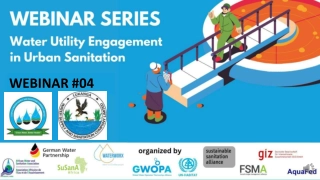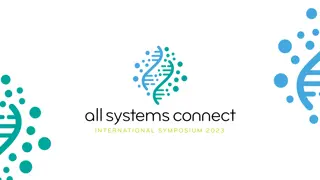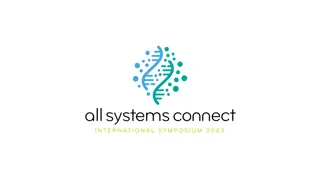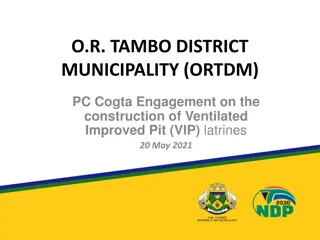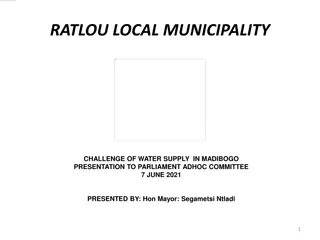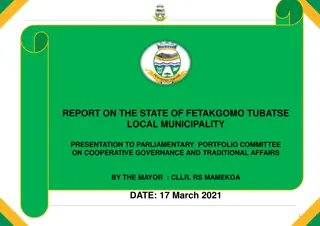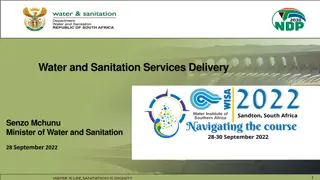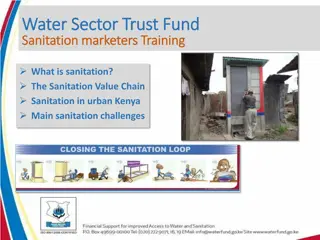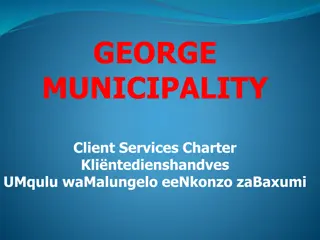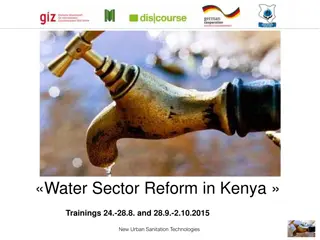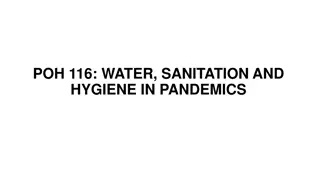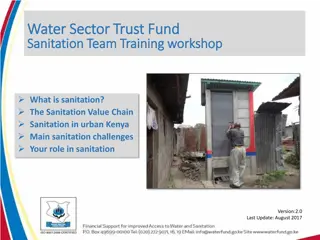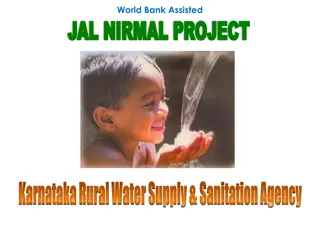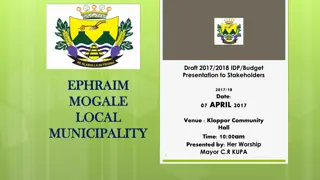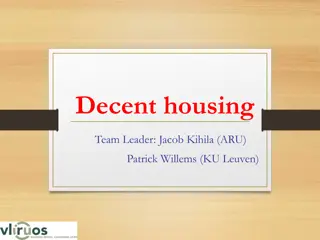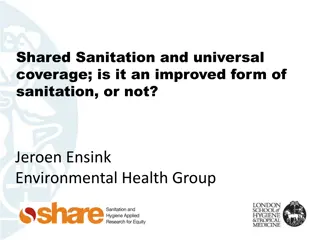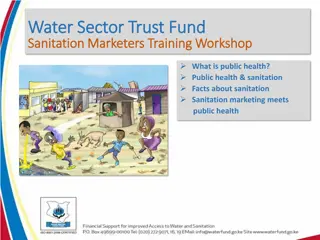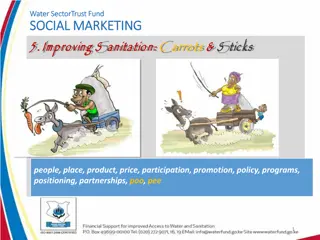Polokwane Water and Sanitation Overview: Improving Water Services for Municipality
Detailed presentation on Polokwane's water and sanitation services, highlighting the municipality's focus on water provision. It covers the strategic vision, challenges faced in urban and rural areas, projected growth in households, and the scheme areas for water services. The integrated water master plan aims to address the full water distribution cycle effectively, enhancing water availability and quality for residents.
Download Presentation

Please find below an Image/Link to download the presentation.
The content on the website is provided AS IS for your information and personal use only. It may not be sold, licensed, or shared on other websites without obtaining consent from the author. Download presentation by click this link. If you encounter any issues during the download, it is possible that the publisher has removed the file from their server.
E N D
Presentation Transcript
POLOKWANE WATER AND SANITATION PRESENTATION FOR CESA MPUMALANGA LIMPOPO WEBINAR 20 MAY 2021
CONTENTS INTRODUCTION MUNICIPAL AREA SCHEME AREAS CITY WATER SUPPLY INFRASTRUCTURE PROGRAMS 2
Introduction Polokwane Water Supply Provision of water in accordance with the obligations of the municipality as Water Services Authority is a high priority for the municipality. To meet Polokwane Municipality s strategic vision, an Integrated Water Master Plan was developed in phases, with an aim toultimately address the full water distribution cycle i.e. from Source-to-Tap-to-Effluent discharge for all areas, and all water supply infrastructure within Polokwane Municipality. The supply areas consist of the City and urban areas as well as an extensive rural area (70%), and both urban and rural areas are facing severe challenges in terms of water services. 3
Polokwane Municipal Area Households & Growth Households 2017 2020 2025 2030 2035 2040 2045 Water Scheme 7 377 7 869 8 436 8 898 9 215 9 354 9 788 Aganang East GWS (New) 11 778 12 462 13 119 13 571 13 770 13 680 13 994 Badimong RWS 10 764 11 402 12 151 12 721 13 059 13 119 13 563 Bakone GWS (New) 2 097 2 240 2 403 2 534 2 622 2 657 2 773 Boyne RWS 8 601 9 286 10 100 10 807 11 358 11 702 12 431 Chuene Maja RWS 9 349 9 893 10 389 10 718 10 843 10 734 10 938 Houtriver RWS 2 928 3 121 3 338 3 518 3 647 3 713 3 905 Laaste Hoop RWS 24 983 27 358 30 528 33 608 36 431 38 809 42 723 Mankweng RWS 7 011 7 467 7 924 8 280 8 505 8 573 8 923 Molepo RWS 10 223 10 968 11 768 12 411 12 841 13 009 13 572 Moletjie East GWS 2 506 2 654 2 789 2 880 2 914 2 886 2 941 Moletjie North GWS 12 968 13 731 14 499 15 040 15 298 15 228 15 603 Moletjie South GWS 10 533 11 595 13 024 14 372 15 550 16 465 17 943 Mothapo RWS 104 116 117 883 139 342 161 932 184 640 206 146 236 984 Olifants-Sand RWS 7 493 7 805 8 106 8 265 8 258 8 069 8 110 Polokwane LM Farms 14 736 15 954 17 538 18 966 20 136 20 948 22 457 Sebayeng-Dikgale RWS 883 924 965 990 995 980 992 Segwasi RWS 248 418 272 686 306 497 339 591 370 162 396 152 437 720 Total 4
Polokwane Water Services - Scheme Areas In terms of water services Polokwane Municipal area consist of 15 Water Regional Scheme area which covers both rural and urban areas namely: Aganang RWS Badimong RWS Boyne RWS Chuene Maja RWS Houtriver RWS Laastehoop RWS Moletji East RWS Moletji North RWS Moletji South RWS Mothapo RWS Olifants Sand RWS Sebayeng Dikgale RWS Mankweng RWS Molepo RWS Segwashi RWS 5
Background Polokwane City Water Supply The main water supply sources currently supplying water to Polokwane City (excl Perskebult boreholes) are: Average Supply to Polokwane City (current) 6.9 ML/day 1.2 ML/day 14 ML/day 1 ML/day 21.6 ML/day 26.1 ML/day 69.4 ML/day Resource Name Polokwane Boreholes Pelgrimshoop Boreholes Dap Naude Dam Seshego Dam Ebenezer Dam (LNW)* Olifants Sand WS (LNW)* TOTAL *Currently Ebenezer WS = 19.9 ML/day average and Olifantspoort WS = 24.8ML/day A water supply shortfall in excess of 30 Ml/day was calculated if water losses are included 6
PROPOSED WATER RESOURCE DEVELOPMENT AND AVAILABILITY A summary of the identified water resources indicating the impact vs the timeframes for interventions is as follows: Perskebult Boreholes Pelgrimshoop boreholes Bloodriver Wellfield Seshego Boreholes Sand river South Wellfield Sterkloop Wellfield Polokwane boreholes Sand river North Wellfield Seshego Dam Ebenezer WS Olifantspoort WS Dap Naude WS Other (incl De Hoop Dam infrastructure, Wastewater reclamation, irrigation buyouts, Malmane dolomites, etc) Water Supply in (ML/day) Short Term Medium Term Long Term Water Resource Current Average Peak Average Peak Average Peak 1.8 1.8 1.8 2.2 2.2 2.2 1.7 3.4 1.7 1.5 3.0 1.5 2.8 5.6 2.8 2.9 5.8 2.9 1.2 2.4 1.2 5.8 11.6 5.8 2.0 2.0 2.0 21.6 21.6 21.6 26.1 26.1 26.1 12.6 12.6 12.6 0.0 1.2 0.0 1.4 0.7 2.2 0.0 2.6 1.0 19.9 24.8 12.6 1.8 4.2 3.4 3.0 5.6 5.8 2.4 11.6 2.0 21.6 26.1 16.0 1.8 2.2 1.7 1.5 2.8 2.9 1.2 5.8 2.0 29.6 48.1 17.9 1.8 4.4 3.4 3.0 5.6 5.8 2.4 11.6 2.0 29.6 48.1 20.9 TBC TOTALS 66.4 82.2 98.1 82.2 103.5 117.5 138.6 7
Polokwane Water Supply - Continued For both rural areas and urban areas groundwater development has been found to offer the best option for immediate / short term development - considering the many associated benefits such as: availability, sustainability, proximity (saving billions in bulk infrastructure), much lower cost of infrastructure as well as maintenance and operational cost, no storage dams, and mostly no expensive treatment required, Therefore groundwater development is given the highest possible priority 8
IDENTIFIED SOLUTIONS - Short Term Solutions The following short-term solutions are being addressed: Identification and exploration of all bulk ground water resources within the boundaries of the City have been completed as part of the first phase of the Water Master Plan. The Water Master Plan for Polokwane Municipality is also complete. Condition assessment of the existing ground water systems within the city boundaries in terms of their stage of functioning and their adequacy is complete. A thorough yield analysis of all the existing and newly identified bulk ground water supply resources was done and additional boreholes were drilled where identified. 9
Strategic Projects (Budget) The Municipality explored all possible funding sources for the implementation of its cstlytic projects as follows: Allocation of its own Internal Capital Reserves Loan Funding through DBSA and IIPSA RBIG WISG 14
Funding challenges The impact of Covid-19 on Infrastructure Development Lower collection rate Grants allocation reduction 15
Projects that may fail to start due to grants reduction Polokwane RWWTW Civil, Mechanical and Electrical; Refurbishment of Mankweng WWTW; Refurbishment of Seshego WWTW; Polokwane WWTW Phase 2 refurbishment. 16



